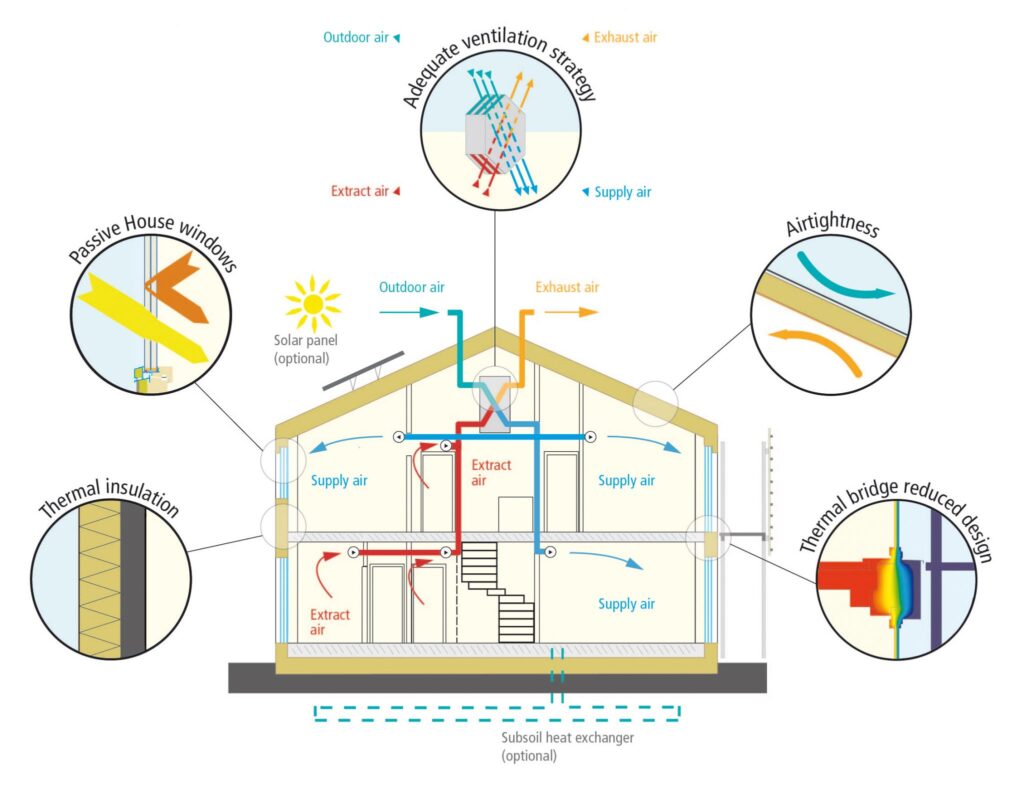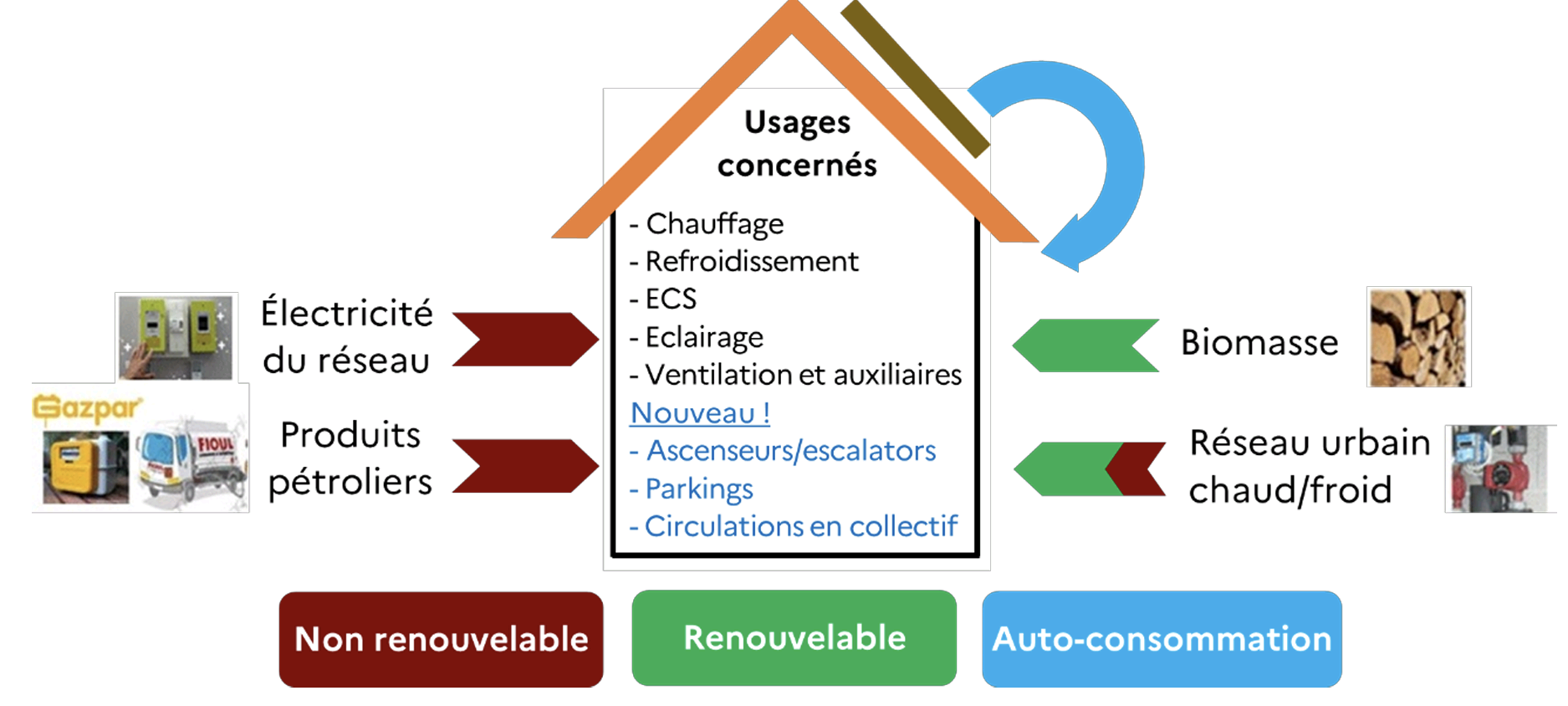Energy and buildings: from energy-hungry to passive
In a world where energy demand from buildings accounts for almost 40% of total energy consumption and contributes around 30% of global CO2 emissions, the issue of energy efficiency in buildings has become crucial. Reducing the energy dependency of buildings is now an imperative if we are to combat climate change and preserve our resources.
1. Building in a world of finite resources
Given the finiteness of natural resources, sustainable construction has become a necessity. Designing buildings to take account of their impact on the environment through a life cycle analysis (LCA), from the extraction of materials to their demolition, is essential if we are to preserve our planet for future generations.

2. The Passivhaus principle
The Passivhaus, or passive house, concept was born of collaboration between German and Swedish professors and is based on bioclimatic design and innovative technologies designed to minimise the energy consumption of buildings. By using high-performance insulation, optimum air-tightness, controlled ventilation and renewable energy sources, passive houses can drastically reduce their energy consumption and even become energy self-sufficient.
Passivhaus house design, as specified by the Passivhaus Institute in Darmstadt, Germany, is based on the following six principles:
1. Very high levels of thermal insulation in the walls and high-quality windows
2. Elimination of thermal bridges
3. Excellent airtightness
4. Double-flow ventilation with heat recovery
5. Optimised (but passive) capture of solar energy and heat from the ground
6. Limited energy consumption for household appliances

3. Regulations and labels (RE2020, tertiary decree, etc.)
Environmental regulations and labels, such as the RE2020 in France or the tertiary sector decree, impose increasingly strict energy performance standards on new and existing buildings. These measures are encouraging players in the property sector to invest in eco-responsible solutions and rethink their practices to reduce their carbon footprint.

What are the energy and environmental performance requirements of the RE2020?
- Bioclimatic need coefficient (Bbio): the ability of a building’s design to passively reduce the need for heating in winter, cooling in summer and artificial lighting.
- Primary energy coefficient (Cep): imported energy required to cover the building’s needs
- Non-renewable primary energy coefficient (Cep,nr): non-renewable energy sources to cover the building’s needs
- Ienergy: impact on climate change of energy consumption during the use of the building over its entire lifespan
- Iccomponent: impact on climate change associated with the building’s components, including the construction site
- Degrees of discomfort hours: level of discomfort perceived by occupants, the building’s interior temperature must not exceed 2 thresholds to avoid discomfort:
- At night, the temperature threshold is 26°C
- During the day, the temperature threshold is

Tertiary sector decree
The aim of the tertiary sector decree is to reduce the energy consumption of new and existing buildings by 40% by 2030, 50% by 2040 and 60% by 2050. All public and private tertiary buildings with a total surface area of more than 1000m² are covered by the tertiary decree. At the same time, the tertiary sector decree requires those subject to it to declare their energy consumption and their reference year. This declaration must be made on the OPERAT platform (Observatoire de la Performance Energétique de la Rénovation et des Actions du Tertiaire).
All new and existing public and private tertiary buildings with a combined floor area of more than 1,000 m² are covered by the tertiary decree:
- health and education establishments
- hotels, restaurants, cafés
- shops
- administrations, offices
- court buildings
- airports, railway stations
- sports and cultural facilities
- logistics
- etc.
Methods for achieving the objectives of the tertiary sector decree
The objectives are progressive. They can be achieved using two alternative methods. The choice will depend on the strategy adopted.
Meeting the target in relative terms
The target corresponds to a reduction in final energy consumption :
- compared with a reference year (chosen by the taxpayer) between 2010 and 2019
- including all energy uses over one year
- adjusted for climatic variations (correction methods defined by decree)
– qualified by the corresponding data on occupancy and intensity of use provided by you.
The values to be met are based respectively on the reference energy consumption, with a reduction of -40% (2030), -50% (2040) and -60% (2050).
Meeting the target in absolute terms
The target is determined :
- for each category of activity
- including all energy use over one year
- by a threshold expressed in kWh/m2/year based on the energy consumption of new buildings in the same activity category and the best available techniques
- taking into account indicators of intensity of use specific to each type of activity.
The values to be complied with are set by decree before the start of each decade, and the targets must be achieved by each deadline (2030, 2040, 2050).
What is the difference between a label and certification?
A label certifies the performance of a material or building without being regulated by law, whereas certification does.
Existing labels :
– BBC, bâtiment basse consommation, is a label awarded to buildings that consume little energy for heating, domestic hot water, ventilation and lighting. On average, a BBC-labelled building is 50% more energy-efficient than other standard buildings.
– BBCA, Bâtiment Bas Carbone (Low Carbon Building). This is used to measure the carbon footprint of a new or renovated building. To measure this carbon footprint, we take into account the construction of the building (sober design, choice of materials), its operation (renewable energies, for example) and carbon storage (bio-sourced materials). There are different levels of performance: BBCA standard, BBCA performance and BBCA excellence.
– The regulatory Bâtiment Biosourcé label is awarded by Certivéa. This label is obtained in conjunction with NF HQE or NF HPE certification.
– The BBC Effinergie label can be awarded to buildings that comply with the 2012 RT (thermal regulations). The requirements of the BBC Effinergie label are that the building should be of high quality, offer a certain level of living comfort, be environmentally friendly and be energy-efficient for its future occupants.
– High Environmental Quality. A building with the HQE label is environmentally friendly from the moment it is built. The housing must have no impact on the external environment (the building site must be low-noise and low-waste).
Certifications :
– ACERMI: label issued by the Association pour la Certification des Matériaux Isolants (Association for the Certification of Insulating Materials). It is used to certify insulating materials on the basis of acoustic, mechanical, reaction to fire and dimensional stability performance requirements. ACERMI insulating materials are tested in advance, so if you use them, you can be sure of their energy performance.
– Issued by Qualitel, NF habitat certification ensures that the home in question is of good quality and technically efficient: good quality of life in the home, economic performance and respect for the environment.
The transition to low-energy buildings is not limited to technical considerations. Thermal and building physics concepts, as well as financial and administrative issues, need to be integrated right from the project management phase. In renovation projects in particular, a holistic approach that takes account of the technical, administrative and financial aspects is essential if the carbon neutrality targets for the building stock are to be met.
https://www.passiv.fr/spip/index.php
https://passivehouse-losangeles.com/passive-house/
https://www.ecologie.gouv.fr/sites/default/files/guide_re2020_version_janvier_2024.pdf

